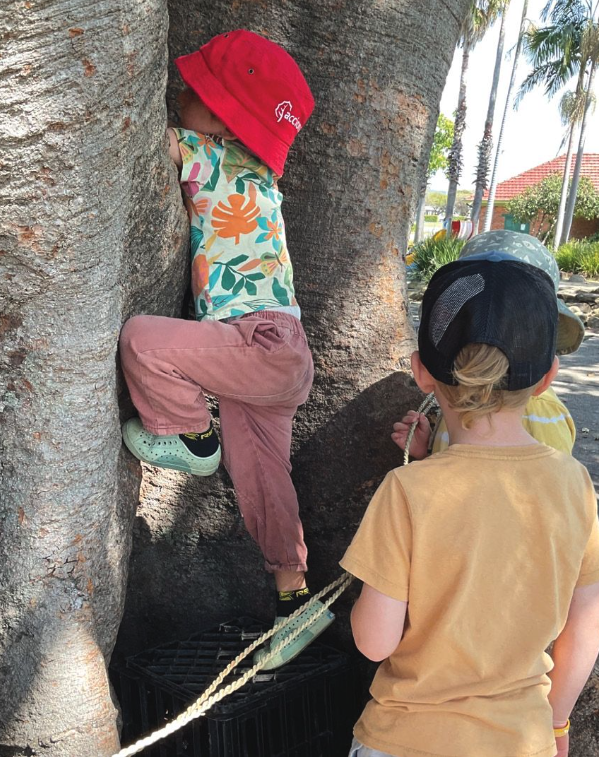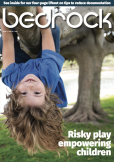Early childhood teacher Alex Sutherland is a recent recipient of the NSW Premier’s Teacher Scholarship, and he’s just back from four weeks overseas studying play pedagogy.
Risky play empowering children
Before becoming a teacher, he worked in the film and television industry, primarily in the art department. “Working in that industry gave me a deep appreciation for creativity, aesthetics, and hands-on experiences,” he says.
His early childhood education and care (ECEC) career began in 2016 when he took a Bachelor of Teaching (Early Childhood/Primary) at the University of Newcastle.
It was during this period that Alex discovered a deep sense of purpose in early childhood. He is now studying a Master of Early Childhood at Macquarie University.
Becoming a teacher at 26 was a surprise change of direction. His mother Jane, an experienced early childhood teacher, may have played a subtle role in his decision.
The NSW Premier’s Teacher Scholarship allows recipients to explore best practices in their chosen focus area through self-led research.
In this article, Alex discusses his research and his philosophical approach towards play.
''Play is central to much of what we do, yet it’s something that’s incredibly difficult to define.''

Synergy with learning
My research centres on the Original Learning Approach, a pedagogical reflective tool developed by Suzanne Axelsson, a Swedish pedagogical consultant, author, and educator.
Suzanne has inspired me for quite some time. Focusing on this approach felt natural because it offers new ways of thinking about early childhood in Australia.
At the heart of Original Learning is the vitality of play and its synergy with learning and teaching.
In early childhood, play is central to much of what we do, yet it’s something that’s incredibly difficult to define.
The scholarship provided me with the opportunity to travel to the United Kingdom and Sweden, where I spent four weeks visiting preschools, adventure playgrounds, ateliers, and play provisions such as playgrounds and exhibitions.
During this time, I conducted in-person interviews, collected digital and physical data, and engaged with relevant readings and blogs.
Upon returning to Australia, I have set out to share my insights into the rich, interweaving nature of Original Learning and its implications for early childhood education and care in Australia.
Original Learning, as a reflective tool, encourages us to think and rethink the context here in Australia.
The depth and interconnected aspects of Original Learning – as well as my findings connected to my experiences in the early childhood sector – continue to shape my work.
Original Learning starts with the notion of play, then branches from there. While the significance of play in children’s learning, development, and wellbeing is well-documented, there is no universal definition of play.

Choice and joy
Axelsson defines play by identifying two key characteristics: choice and joy.
During my time in the United Kingdom, I had the opportunity to observe the Playwork approach firsthand, a major influence on Original Learning.
This was instrumental in understanding what is defined as ‘play’ and what is defined as ‘non-play’ from the perspective of Original Learning.
In the Original Learning Approach, play originates with children and belongs to them. This perspective emphasises that children’s play can be adulterated — meaning interrupted, controlled, manipulated, or (over)scheduled.
Reflecting on this idea within my practice, I thought, ‘It’s about having a deep respect for children by honouring their right to play and trusting in their self-directed play’.
Physical risk-based play is a powerful means of children’s play. My visits to three adventure playgrounds in Wrexham, Wales, led by Playworkers, reinforced this perspective.
I noted the similarities between Playwork and my own working experience, highlighting the Playworkers’ ‘visibly invisible’ approach, where they are always ready to support children — whether by being present or by adjusting the environment — without interfering in their play processes.
Supporting physical risky play is largely about creating conditions and environments that challenge children in a healthy and appropriate way. It’s certainly not about letting them do whatever they want, but about scaffolding their capabilities and bravery.
This approach is primarily achieved by starting small and gradually increasing the complexity for children.

Start simply
For example, when using fire pits with children, it begins with something as simple as a tea-light candle at the lunch table. This becomes a catalyst for discussion and developing children’s ability to conduct an informal risk assessment.
I have always enjoyed working in early childhood settings that allow children unstructured, self-directed time to play.
I discovered that the concept of ‘autonomous play’ in the Original Learning Approach offered fresh perspectives on the idea of autonomy.
In Australia, children are often viewed as individual autonomous learners, yet in Original Learning, the word ‘interdependence’ is key.
The Original Learning Approach broadens the concept of autonomy by emphasising that personal autonomy must not impede the autonomy of others, which offers valuable insights for early childhood education in Australia.
The idea of autonomy as described in Original Learning is visible in gathering children for a ‘morning meeting.’
I really enjoy engaging in daily morning meetings where the children share their play ideas, questions, or thoughts. It became an essential time for reflection, listening, and sharing ideas together.
These morning meetings were guided by specific parameters. The children understood that entering a circle meant no one – neither adults nor children – held more power, and everyone’s voice was equally valued and deserved to be heard.
To help children begin the day calmly and mindfully, I use deep breathing exercises assisted by a singing bowl. A ‘yarning stick’ supports children in these meetings, allowing them to practice turn-taking and build the confidence to speak in front of others.
For some children, speaking in a group is a big personal risk, and I’ve seen it take months for some to build up the courage.

Democratic practice
The morning meeting is more than just a gathering; it is a space for fostering children’s democratic practice, a core element of the Original Learning Approach.
Axelsson describes this as ‘mwe’ – a blend of ‘me’ and ‘we’ – which advocates for children to feel valued, develop a sense of belonging, and actively participate in a community.
Another key insight from my research was the concept of a ‘play-responsive’ pedagogy, as outlined in the Original Learning Approach. This pedagogy brings to life the diverse rhythms of children’s play and encourages educators to rethink about play beyond normative cultural and neurotypical assumptions.
A play-responsive pedagogy emphasises the importance of understanding play deeply to create inclusive learning environments where children’s play informs the teaching approach.
Central to this pedagogy is the recognition that when children play, they are not just engaging in actions but are also feeling the essence of play.
Original Learning further explores this by discussing how children, when playing autonomously, can enter a ‘flow’ state – an immersive experience where they become fully absorbed in an activity, and everything else fades away.
This concept is rooted in research on the brain’s neuro-connectivity and is crucial for understanding how children and their surroundings co-exist.
I have witnessed this flow state firsthand, particularly when woodworking with children. I’ve noticed children enter a flow state when they are deeply invested in something, like woodwork.
Like other forms of physical risky play, I worked with the children to gradually build their competence and safe handling of tools over time. Children learn quickly, and we were able to move on to some exciting projects.
''Children’s play can be adulterated— meaning interrupted, controlled, manipulated, or (over)scheduled.''
Creative spark
Integrating woodwork with creative arts and using recycled loose parts sparks a strong interest in children. I have made sculptures with them using timber and recycled materials, including bottle caps, pieces of dowel, and more which were donated by surrounding businesses.
These designs were inspired by an excursion to Sculpture by the Sea with a colleague. The children designed their own sculptures, and it became a truly creative process.
Woodwork requires significant chunks of time, allowing children to engage in deep exploration, problem-solving, and idea-making – the perfect environment for entering a state of flow.
A final significant finding from my research was the identification of three distinct roles that educators can take within the Original Learning Approach: the playworker, the facilitator, and the teacher.
Each role is unique, yet fluidity in transitioning between them is essential to align seamlessly with children’s play flow.
This perspective offers fresh insights into the concept of ‘Intentionality’ as outlined in the updated Early Years Learning Framework.
This fluidity between roles has happened in past experiences, such as a particular project where I supported children’s emergent understanding of measurement through their interest in parkour.
In the role of a playworker, I created an environment where children could explore and practice parkour movements freely.
Transitioning into the facilitator role, I engaged with the children to scaffold their informal risk assessment and movement techniques, such as how to roll safely to avoid injury.
As a teacher, I deepened their knowledge by introducing creative provocations for parkour planning.
One example involved using charcoal to encourage children to continue the vigorous movements of parkour through mark making, blending physical activity with artistic expression.
This ability to move fluidly between roles – playworker, facilitator, and teacher – enabled me to support the children’s learning and development in a way that was both intentional and responsive to their interests and needs.
Reference
Axelsson S, 2023 The Original Learning Approach: Weaving Together Play, Learning and Teaching in Early Childhood. (1st ed.). Routledge









































































































































